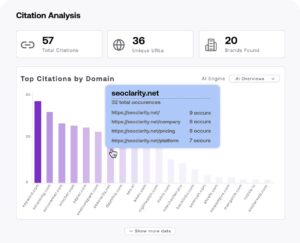Ever asked an AI where it got its info, and it confidently replied, “Trust me, bro”? Yeah, that’s exactly why AI/LLM tracking citations exist.
When a large language model (LLM) gives you an answer, it’s basically remixing information from a mountain of data — like textbooks, websites, Reddit threads, and maybe your aunt’s embarrassing Facebook post from 2014. Without citations, you just have to hope it didn’t hallucinate the details.
So let’s talk about what citations are in this context, why they matter, and how to read them without your eyes glazing over.
What Are LLM Citations?

Think of citations as receipts for AI answers.
When a model “cites” something, it’s showing you the source of a particular claim or fact — a bit like how your high school teacher made you add footnotes, but with less suffering (usually).
-
LLM citations show where specific chunks of information came from.
-
They help trace accuracy, detect bias, and build trust in what the model says.
-
They’re especially useful when the AI is summarizing documents, pulling quotes, or answering with up-to-date info from the web.
In short: no citation = possible hallucination.
Why Citations Matter
Here’s why tracking citations isn’t just a nerdy detail — it’s actually a big deal:
-
Accountability: You can check whether the AI is quoting a reputable source or just winging it.
-
Transparency: You see which sites or documents influenced the answer — not just the final output.
-
Fact-checking: Perfect for when the AI sounds a little too confident.
-
Bias spotting: You can notice if the AI keeps leaning on certain outlets or perspectives.
Basically, citations are AI showing you its receipts.
Where the Sources Come From
When an LLM provides citations, it’s usually pulling from one of these:
-
Uploaded documents (like PDFs, transcripts, or contracts)
-
Public websites (when browsing or search features are enabled)
-
Knowledge bases (internal company data)
-
Research papers or databases (for scientific or technical questions)
Each citation connects the answer directly to the chunk of text that influenced it. So if the AI says something wild, you can click through and catch it red-handed.

How to Read Citations Like a Pro
Here’s your crash course:
-
Follow the source: Click or expand it if possible. See the original text — don’t just trust the summary.
-
Check context: Read a few lines before and after the cited part. AI sometimes misinterprets tone or sarcasm (oh, the irony).
-
Spot repeats: If you see the same source over and over, that’s what the model is leaning on. This can be used to monitor and manipulate Sentiment Score as well.
-
Cross-check: If multiple citations disagree, that’s your cue to dig deeper.
Bonus tip: If there are no citations at all, and the answer sounds polished — be suspicious. It’s like someone saying “I read it somewhere” during a debate.
Why You Should Care (Even If You’re Not a Data Nerd)
If you use AI for research, writing, marketing, or brand monitoring, you need to know where the info’s coming from.
Because here’s what’s at stake:
-
Accuracy: You don’t want to quote fake stats in your client report.
-
Credibility: Being able to say, “This came from X source” makes you look like you know what you’re doing.
-
Legal safety: Some industries require verifiable sources (looking at you, healthcare and finance).
-
AI trust: Citations make AI a partner you can double-check, not just a confident liar.
LLM tracking citations is basically how you turn an AI answer from “maybe true” to “provably sourced.”
It’s the difference between AI storytelling and AI accountability.
So next time your AI assistant drops a detailed answer, peek at the tiny citations. They’re not just there for decoration — they’re the breadcrumbs leading back to truth (or at least to where the AI thinks truth lives).

